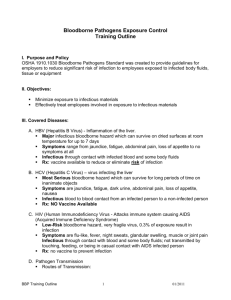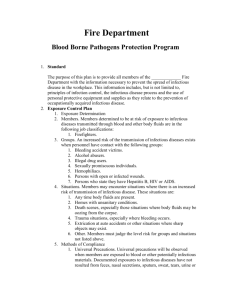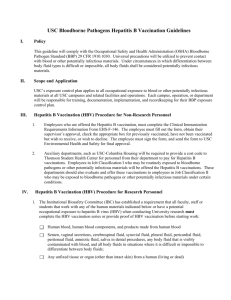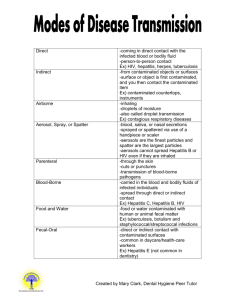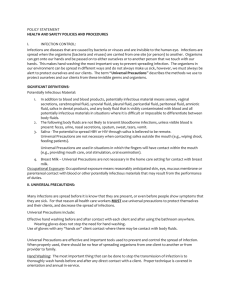Bloodborne Pathogen Procedures
advertisement
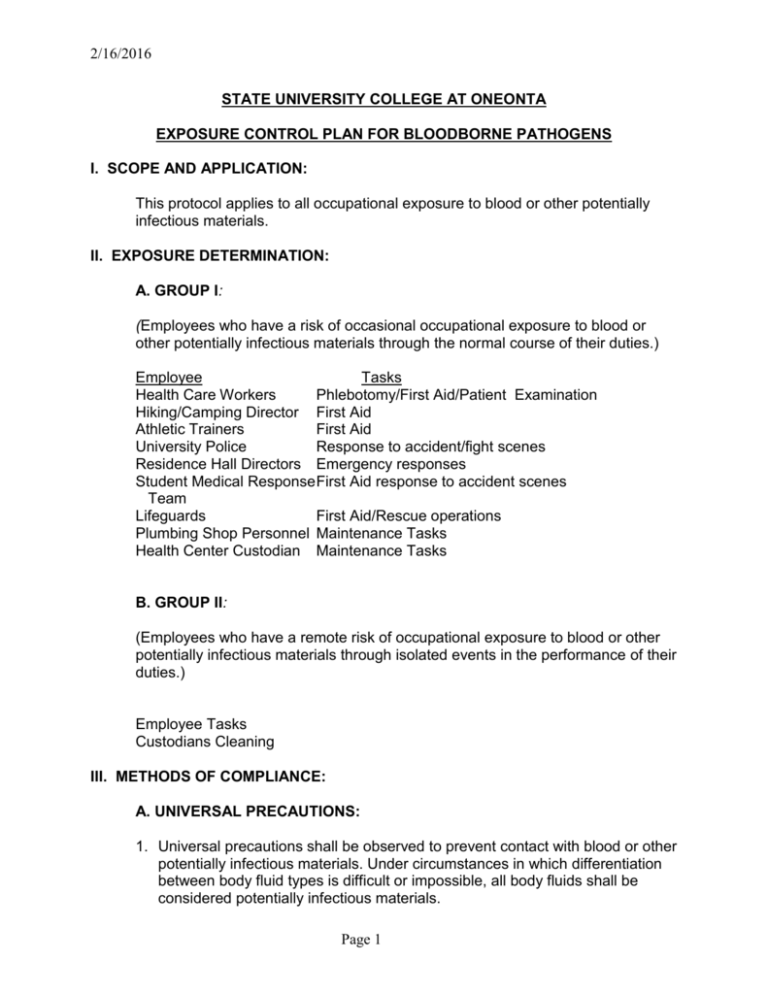
2/16/2016 STATE UNIVERSITY COLLEGE AT ONEONTA EXPOSURE CONTROL PLAN FOR BLOODBORNE PATHOGENS I. SCOPE AND APPLICATION: This protocol applies to all occupational exposure to blood or other potentially infectious materials. II. EXPOSURE DETERMINATION: A. GROUP I: (Employees who have a risk of occasional occupational exposure to blood or other potentially infectious materials through the normal course of their duties.) Employee Tasks Health Care Workers Phlebotomy/First Aid/Patient Examination Hiking/Camping Director First Aid Athletic Trainers First Aid University Police Response to accident/fight scenes Residence Hall Directors Emergency responses Student Medical Response First Aid response to accident scenes Team Lifeguards First Aid/Rescue operations Plumbing Shop Personnel Maintenance Tasks Health Center Custodian Maintenance Tasks B. GROUP II: (Employees who have a remote risk of occupational exposure to blood or other potentially infectious materials through isolated events in the performance of their duties.) Employee Tasks Custodians Cleaning III. METHODS OF COMPLIANCE: A. UNIVERSAL PRECAUTIONS: 1. Universal precautions shall be observed to prevent contact with blood or other potentially infectious materials. Under circumstances in which differentiation between body fluid types is difficult or impossible, all body fluids shall be considered potentially infectious materials. Page 1 2/16/2016 B. ENGINEERING AND WORK PRACTICE CONTROLS: 1. Engineering and work practice controls shall be used to eliminate or minimize employee exposure. Where occupational exposure remains after institution of these controls, personal protective equipment shall also be used. 2. Employees shall wash their hands immediately or as soon as feasible after the removal of gloves or other personal protective equipment. 3. Employees shall wash their hands and any other skin with soap and water, or flush mucous membranes with water immediately or as soon as feasible following contact of such body areas with blood or other potentially infectious materials. 4. Contaminated needles and other contaminated sharps shall be disposed of in approved, marked, puncture-resistant containers and will not be bent, recapped, or removed. Shearing or breaking of needles is prohibited. 5. Eating, drinking, smoking, applying cosmetics or lip balm, and handling contact lenses are prohibited in work areas where there is a reasonable likelihood of occupational exposure. 6. Food and drink shall not be kept in refrigerators, freezers, shelves, cabinets or on countertops or benchtops where blood or other potentially infectious materials are present. 7. All procedures involving blood or other potentially infectious materials shall be performed in such a manner as to prevent splashing, spraying, spattering, and generation of droplets of these substances. 8. Mouth pipetting/suctioning of blood or other potentially infectious materials is prohibited. 9. Specimens of blood or other potentially infectious materials shall be placed in a container which prevents leakage during collection, handling, processing, storage, transport or shipping. 10. Containers for storage, transport, and shipping shall be labeled or colorcoded. 11. Employees shall utilize gloves, gowns, laboratory coats, face shields, masks and eye protection as appropriate. Personal protective equipment shall be considered "appropriate" only if it does not permit blood or other potentially infectious materials to pass through to or reach the employee's work clothes, street clothes, undergarments, skin, eyes, mouth or other mucous membranes under normal conditions of use and for the duration of time which the protective equipment will be used. 12. If a garment is penetrated by blood or other potentially infectious materials, the garment shall be removed immediately or as soon as possible and laundered in the facility. 13. Protective equipment shall be removed prior to leaving the work area. When personal protective equipment is removed, it shall be placed in an appropriately designated area or container for storage, washing decontamination or disposal. 14. Gloves shall be worn when it can be reasonably anticipated that the employee may have hand contact with blood, other potentially infectious materials, mucous membranes, and non-intact skin, when performing Page 2 2/16/2016 vascular access procedures, and when handling or touching contaminated items or surfaces. 15. Disposable, single use gloves such as surgical or examination gloves shall be replaced as soon as practical when contaminated or as soon as practical when contaminated or as soon as feasible if they are torn, punctured, or when their ability to function as a barrier is compromised. 16. Disposable gloves shall not be washed or decontaminated for re-use. 17. Utility gloves may be decontaminated for re-use if the integrity of the glove is not compromised. However, they must be discarded if they are cracked, peeling, torn, punctured, or exhibit other signs of deterioration or when their ability to function as a barrier is compromised. 18. Masks in combination with eye protection devices such as goggles or glasses with solid side shields or chin-length face shields shall be worn wherever splashes, spray, spatter, or drops of blood or other potentially infectious materials may be generated and eye, nose, or mouth contamination can be reasonably anticipated. 19. Surgical caps or hoods and/or shoe covers shall be worn in instances when gross contamination can reasonably be anticipated. C. HOUSEKEEPING: 1. A written schedule for cleaning and decontamination wIll be posted for the Health Center. 2. All equipment and environmental and working surfaces shall be cleaned and decontaminated after contact with blood or other potentially infectious materials. 3. Contaminated work surfaces shall be decontaminated with an appropriate disinfectant immediately upon completion of procedures or instances involving overtly contaminated surfaces. Protective coverings such as plastic wrap, aluminum foil, or imperviously backed absorbent paper shall be removed and replaced as soon as feasible. 4. All bins, pails, cans, and similar receptacles intended for reuse which have a reasonable likelihood for becoming contaminated shall be cleaned and decontaminated on a regularly scheduled basis as soon as feasible upon visible decontamination. 5. Broken glassware which may be contaminated shall not be picked up directly with the hands, but rather with mechanical means such as dust pans and tongs. D. REGULATED WASTE 1. Contaminated sharps shall be deposited immediately in containers that are closable, labeled, puncture resistant, and leakproof on the sides and bottom. 2. During use, containers for contaminated sharps shall be easily accessible to personnel and maintained upright during use. 3. Containers shall be replaced routinely and not be subject to overfilling. Page 3 2/16/2016 4. Other regulated waste shall be placed in closable containers, constructed to contain all contents and prevent leakage. These containers shall be color coded and closed prior to removal. E. LAUNDRY 1. Contaminated laundry shall be handled as little as possible with a minimum of agitation. It shall be bagged or containerized at the location where it was used and shall not be sorted or rinsed in the location of use. Bags and containers shall be impervious to leakage and soak-through. 2. Employees who have contact with contaminated laundry shall wear protective gloves and other appropriate personal protective equipment. IV. HEPATITIS B VACCINATION AND POST-EXPOSURE EVALUATION AND FOLLOW-UP: A. VACCINATION: 1. The Hepatitis B vaccination series shall be made available to employees in Group I at no cost to the employee at a reasonable place and time, performed by or under the supervision of a licensed physician or licensed health care professional. 2. Hepatitis B vaccination shall be made available after the employee has received training and within 10 days of assignment to employee Group I unless: a) the employee has previously received the complete hepatitis B vaccination series b) antibody testing has revealed that the employee is immune c) the vaccine is contraindicated for medical reasons 3. If an employee initially declines vaccination but at a later date while still covered under this protocol decides to accept vaccination, it shall be provided at that time. 4. Employees who decline to accept vaccination offered by the employer shall sign the statement in Appendix A. 5. Booster doses of hepatitis B vaccine shall be made in accordance with the above procedures. B. POST-EXPOSURE EVALUATION AND FOLLOW-UP: 1. Post exposure evaluation and follow-up shall be made available to all employees who have had an exposure incident. Contact the SUNY Oneonta Facilities and Safety Office at ext 3224 or the Health Center at ext 3573. An incident report and a sharps injury log form will be completed on the exposed employee. Page 4 2/16/2016 2. Laboratory tests of the exposed employee and source patient shall be conducted by an accredited laboratory at no cost to the employee. 3. Following a report of an exposure incident, the employer shall make immediately available to the exposed employee a confidential medical evaluation and follow-up at A.O. Fox Memorial Hospital, including at least the following elements: 4. Identification of the source individual will be investigated by the college and notification will be provided to the exposed employee if consent of the source patient is obtained and not restricted by law. Test results for HIV/HBV/HCV will be given to all involved upon consent and under protection of patient rights. At all times confidentiality of the exposed employee and source patient will be observed. 5. The source individual's blood shall be tested as soon as feasible if consent is obtained to determine HIV/HBV/HCV infectivity following pre-counseling for HIV. 6. The exposed individual's blood shall be collected as soon as feasible and tested at A.O. Fox Memorial Hospital after consent is obtained. If the exposed individual consents to baseline blood collection, but does not give consent at that time for HIV serologic testing, the sample shall be preserved for at least 90 days. If, within 90 days of exposure incident, the employee elects to have the baseline sample tested, such testing shall be done as soon as feasible. 7. Post-exposure prophylaxis, when medically indicated, shall be provided in accordance with the guidelines promulgated by the U.S. Public Health Service. 8. The health care professional evaluating an employee after an exposure incident shall be provided the following information: a copy of CFR 1910.1030 ("OSHA Bloodborne Pathogen Standard") a description of the exposed employee's duties as the relate to the incident c) documentation of the route of exposure and the circumstances under which the exposure occurred d) the source individual’s blood test information. e) all medical records relevant to the appropriate treatment of the employee including vaccination status a) b) 9. The employee shall be provided with a copy of the evaluating health care professional's written opinion within 15 days of the completion of the evaluation. The health care professional's written opinion for Hepatitis B vaccination shall be limited to whether Hepatitis B vaccination is indicated for an employee and if the employee has received such vaccination. Follow-up for Hep B vaccinations will be done at the Student Health Center as required. 10. The health car professional's written opinion for post-exposure evaluation and follow-up shall be limited to the following information: a) that the employee has been informed of the results of the evaluation Page 5 2/16/2016 b) that the employee has been told about any medical conditions resulting from exposure to blood or other potentially infectious materials which require further evaluation or treatment 11. All other findings or diagnoses shall remain confidential. V. COMMUNICATION OF HAZARDS TO EMPLOYEES: A. LABELS AND SIGNS: 1. Warning labels shall be affixed to containers of regulated waste, refrigerators and freezers containing blood or other potentially infectious material, and other containers used to store, transport or ship blood or other potentially infectious materials. 2. Labels shall contain the BIOHAZARD symbol 3. These labels shall be fluorescent orange or orange-red or predominantly so with lettering in a contrasting color. 4. Red bags or red containers may be substituted for labels. 5. Individual containers of blood or other potentially infectious materials that are placed in a labeled container during storage, transport, shipment or disposal are exempted from the labeling requirement. 6. Labeling requirements shall also pertain to contaminated equipment and shall so state which equipment is contaminated. VI. INFORMATION AND TRAINING: A. TRAINING WILL BE PROVIDED AS FOLLOWS: 1. At the time of initial assignment to the Group I employee category. 2. At least annually thereafter and within a year of previous training. 3. Additional training shall be provided when changes such as a modification of task assignment occur. 4. Training for employees in Group II will be conducted as part of Hazard Communication/Right to Know Training sessions. 5. TRAINING FOR GROUP I EMPLOYEES WILL INCLUDE THE FOLLOWING: An accessible copy of the "OSHA" regulatory text. A general explanation of the epidemiology and symptoms of bloodborne diseases. c) An explanation of the modes of transmission of bloodborne pathogens. d) An explanation of the college Exposure Control Plan. e) An explanation of the appropriate methods for recognizing tasks and other activities that may involve exposure to blood and other potentially infectious materials. a) b) Page 6 2/16/2016 An explanation of the use and limitations of methods that will prevent or reduce exposure including work practices, engineering controls, and personal protective equipment. g) Information on the types, proper use, location, removal, handling, decontamination and disposal of personal protective equipment. h) Information on the hepatitis B vaccine, including information on its safety and method of administration. i) An explanation of the procedure to follow if an exposure incident occurs, including the method of reporting the incident and the medical follow-up that will be made available. j) Information on the post-exposure evaluation procedure. k) An explanation of the signs and label system. l) An opportunity for interactive questions and answers. f) 6. The person conducting the training shall be knowledgeable in the subject matter covered by the elements contained in the training program as it relates to the workplace that the training will address. VII. RECORD KEEPING A. INDIVIDUAL EMPLOYEE RECORDS 1. An accurate record for each Group I employee shall be maintained. The record shall include the following: a) b) c) d) e) f) g) VIII. Name and social security number Copy of the employee's hepatitis B vaccinations and any medical records relative to the employee' ability to receive the vaccination Copy of all results of examinations, medical testing, and follow-up procedures The employer's copy of health care professionals' written opinions Copy of all information provided to health care professionals. Employee records shall remain confidential. Employee records shall be retained for 30 years. TRAINING RECORDS A. INFORMATION REQUIRED: 1) 2) 3) Dates of training sessions Names and qualifications of persons conducting the training Names and job titles of all persons attending training sessions. B. RECORDS SHALL BE MAINTAINED FOR 3 YEARS Page 7 2/16/2016 IX. RECORD AVAILABILITY A. Training records shall be made available for examination upon request to employees. B. Medical records for specific employees shall be made available for examination only to those having the written consent of the subject employee. Page 8 2/16/2016 APPENDIX A MANDATORY HEPATITIS B VACCINE DECLINATION FORM I UNDERSTAND THAT DUE TO MY OCCUPATIONAL EXPOSURE TO BLOOD OR OTHER POTENTIALLY INFECTIOUS MATERIALS, I MAY BE AT RISK OF ACQUIRING HEPATITIS B VIRUS (HBV) INFECTION. I HAVE BEEN GIVEN THE OPPORTUNITY TO BE VACCINATED WITH HEPATITIS B VACCINE, AT NO CHARGE TO MYSELF. HOWEVER, I DECLINE HEPATITIS B VACCINATION AT THIS TIME. I UNDERSTAND THAT BY DECLINING THIS VACCINE, I CONTINUE TO BE AT RISK OF ACQUIRING HEPATITIS B, A SERIOUS DISEASE. IF IN THE FUTURE I CONTINUE TO HAVE OCCUPATION EXPOSURE TO BLOOD OR OTHER POTENTIALLY INFECTIOUS MATERIALS AND I WANT TO BE VACCINATED WITH HEPATITIS B VACCINE, I CAN RECEIVE THE VACCINATION AT NO CHARGE TO ME. ___________________________ EMPLOYEE SIGNATURE Page 9
